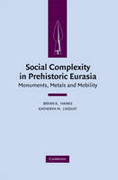
Social complexity in prehistoric eurasia: monuments, metals and mobility
Hanks, Bryan K.
Linduff, Katheryn M.
Social Complexity in Prehistoric Eurasia challenges current interpretations of the emergence, development, and decline of social complexity in the steppe region of China and the former Soviet Union. Through a thematic investigation of archaeological patterns ranging from monument construction and use and production and consumption of metals to the nature of mobility among societies, theessays in this volume provide the most up-to-date thinking on social and cultural change in prehistoric Eurasia. Collectively, they challenge broader theoretical trends in Anglo-American archaeology, which have traditionally favored comparative studies of sedentary agricultural societies over mobile pastoralist or agro-pastoralist communities. By highlighting the potential and limitations of comparative studies of social complexity, this volume sets the agenda for future studies of this region of the world. It emphasizes how the unique nature of early steppe societies can contribute to more comprehensive interpretations of social trajectories in world prehistory. INDICE: 1. Introduction Bryan Hanks and Katheryn Linduff; Part I. Framing Complexity: 2. Introduction Ledmila Koryakova; 3. Differentiated political landscapes and non-uniform complexity in Bronze Age steppe archaeology Michael Frachetti; 4. Climate change, conflict, and the origins of the Sintashta-Arkaim complex David Anthony; 5. Settlements and necropolises of the Bronze Age of the Urals: opportunities for the reconstruction of social dynamics Andrei Epimakhov; 6. The Maikop singularity: a unique example of the unequal accumulation of wealth on the Bronze Age Eurasian steppes? Phil Kohl; Part II. Mining, Metallurgy and Trade: 7. Introduction Katheryn Linduff; 8. Formation of the Eurasian steppe belt of stockbreeding cultures: viewed through the prism of archaeometallurgy and radiocarbon dating Evgenii Chernykh; 9. Modelling early metallurgical production and community organization Bryan Hanks; 10. Technology and exchange: the metallic artifacts excavated in the ancient Dian region of Yunnan province from 5th c. BC to 2nd c. AD Han Rubin and Li Xiaocen; 11. Metal makingand social complexity in the Bronze Age Steppes: material culture practices and value David Peterson; 12. Early metallurgy and socio-cultural complexity: aview based on archaeological discoveries in eastern Central Asia Jianjun Mei;Part III. Frontiers and Border Dynamics: 13. Introduction Tom Barfield; 14. Violence on the frontiers? Sources of power and socio-political change at the easternmost parts of the Eurasian steppes during the early first millennium BCEGideon Schelach; 15. First millennium BCE Beifang artifacts as historical documents Emma Bunker; 16. Blurring the boundaries: uncovering the complex interactions between foragers and pastoralists in the Volga-Ural region Laura Popova; Part IV. Social Power, Monumentality and Mobility: 17. Introduction Francis Allard; 18. Re-writing monumental landscapes as inner Asian political process William Honeychurch, Joshua Wright and Chunag Amartuvshin; 19. 'Socially integrative facilities' and the emergence of societal complexity on the Mongolian steppe Jean-Luc Houle; 20. Deer stones and khirigsuurs: pre-Scythian Bronze Ageceremonialism and art in northern Mongolia William Fitzhugh.
- ISBN: 978-0-521-51712-6
- Editorial: Cambridge University
- Encuadernacion: Cartoné
- Páginas: 417
- Fecha Publicación: 01/08/2009
- Nº Volúmenes: 1
- Idioma: Inglés
